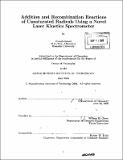| dc.contributor.advisor | William H. Green. | en_US |
| dc.contributor.author | Ismail, Huzeifa | en_US |
| dc.contributor.other | Massachusetts Institute of Technology. Dept. of Chemistry. | en_US |
| dc.date.accessioned | 2009-06-30T17:08:21Z | |
| dc.date.available | 2009-06-30T17:08:21Z | |
| dc.date.copyright | 2008 | en_US |
| dc.date.issued | 2008 | en_US |
| dc.identifier.uri | http://hdl.handle.net/1721.1/46046 | |
| dc.description | Thesis (Ph. D.)--Massachusetts Institute of Technology, Dept. of Chemistry, 2008. | en_US |
| dc.description | Includes bibliographical references (leaves 198-208). | en_US |
| dc.description.abstract | This thesis describes the construction of a novel, low-noise laser kinetics spectrometer. A quasi-CW (picosecond pulse), tunable Ti:Sapphire laser is used to detect various transient species in laser flash photolysis kinetics experiments via direct absorption. The spectral range of the laser, when used with a harmonic generator, covers most of the visible wavelength region, allowing for the detection of a wide array of organic radical species. Paired with a temperature-and pressure-controlled flow reactor equipped with a Herriott-type optical multiple pass cell, transient absorptions of ~0.0001 can be measured, corresponding to cross section - concentration products of less than 1x10-7 cm". The flexibility and high sensitivity of this instrument allows direct and accurate measurement of many important transient intermediates in combustion and atmospheric chemistry.Using this instrument, we report the self-reaction rate coefficient of vinyl and allyl radicals. Vinyl iodide and allyl iodide are used as precursors to generate respective radicals via laser-flash photolysis at 266 nm. Second order chemical reactions require an accurate determination of the initial radical concentration, which we determined using direct laser absorption by I atom at 1315 nm. The current study finds the self-reaction rate constant for vinyl radical to be more than a factor of two slower than previous studies and allyl self reaction rate constant to be 50% faster than values reported in the literature. The absorption cross sections of the vinyl radical at 404, 423.2, & 445 nm and allyl radical at 404 & 408 nm are also determined. This thesis also reports measurements of rate coefficients for the reaction of vinyl radical with various alkenes: ethylene, propene, isobutene, 1-butene, and 2-butene,performed over a temperature range of 300 K to 700 K at 100 Torr. The measured vinyl radical disappearance rates compare well with ab initio quantum calculations. The combined measurements and calculations provide improved estimates for other vinyl + alkene reactions. | en_US |
| dc.description.statementofresponsibility | by Huzeifa Ismail. | en_US |
| dc.format.extent | xx, 208 leaves | en_US |
| dc.language.iso | eng | en_US |
| dc.publisher | Massachusetts Institute of Technology | en_US |
| dc.rights | M.I.T. theses are protected by
copyright. They may be viewed from this source for any purpose, but
reproduction or distribution in any format is prohibited without written
permission. See provided URL for inquiries about permission. | en_US |
| dc.rights.uri | http://dspace.mit.edu/handle/1721.1/7582 | en_US |
| dc.subject | Chemistry. | en_US |
| dc.title | Addition and recombination reactions of unsaturated radicals using a novel laser kinetics spectrometer | en_US |
| dc.type | Thesis | en_US |
| dc.description.degree | Ph.D. | en_US |
| dc.contributor.department | Massachusetts Institute of Technology. Department of Chemistry | |
| dc.identifier.oclc | 370432327 | en_US |
